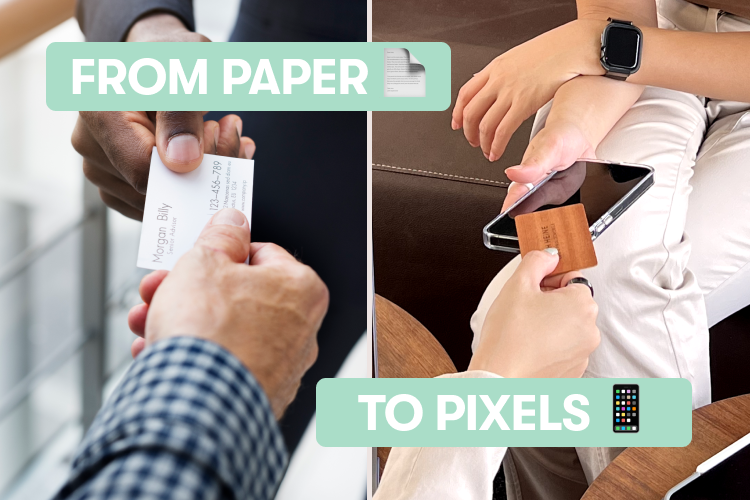
The Evolution of Name Cards: From Paper to Pixel
|
|
Time to read: 6 min
From traditional paper exchanges to digital innovations like One Good Card, the evolution of name cards mirrors a shift towards sustainable, tech-savvy, and eco-friendly networking practices.
The Dawn of Digital Name Cards: Transforming Networking in the Digital Age
The exchange of name cards was a ritual in professional circles. These small pieces of paper, adorned with contact details, were the linchpin of networking. In the fast-paced digital era, where information travels at the speed of light, traditional paper business cards are making way for their sleek and dynamic counterpart – digital name cards. These digital marvels are redefining the way professionals connect, share information, and leave a lasting impression.
So, let’s embark on a journey into the introduction of digital name cards and explore the exciting transformations they bring to the world of networking.
The Evolution of name cards: from paper to pixel
A firm handshake and the exchange of name cards were the hallmarks of a professional introduction. Traditional paper name cards were considered essential tools for networking. They were tangible, elegant, and carried a sense of formality.
When people exchanged these cards, it wasn't just about sharing contact information; it symbolized making a connection, a potential partnership, or the chance for future opportunities. The act of giving someone these tangible cards held a special meaning, embodying professional identity and building trust in the business world.
However, these cards hold their own limitations too.
What if my job situation changes and those once crucial connections slip away? How can I reach out to my networks if I've misplaced their paper name cards? And what if opportunities to pitch ideas arise, but my documents are left behind in the office?
The limitations of relying solely on traditional methods become evident in the evolving landscape, underscoring the need for more versatile and resilient tools in the dynamic evolution of professional networking and idea presentation.

Limitations of Traditional Name Cards
As the world evolved, so did the challenges associated with traditional name cards.
Limited Information: Paper name cards offered a snapshot of contact information, but any changes required the printing of new cards.
Lack of Interactivity: Paper name cards lacked interactive elements that could enhance networking experiences.
Limited Global Reach: Often confined to physical interactions and can be challenging to share with contacts in different regions.
Missed Analytics: No way to track how often they are shared, viewed, or acted upon, limiting the ability to measure their impact and optimize networking efforts.
Environmental Impact: The production and disposal of paper business cards contributed to environmental concerns.
Limited information & Lack of Interactivity
Paper name cards present challenges due to their static nature and limited space. It provides only basic contact information such as name, phone number, and email address. This static content does not allow for customization or updating, making it challenging to provide additional details or changes in contact information.
The small size of a paper name card further restricts the amount of information that can be included, making it difficult to provide a comprehensive overview of an individual or business. This limitation means missed opportunities to showcase a full range of services, products, or skills, hindering effective networking and communication.
Additionally, paper name cards do not offer interactive elements that can provide additional information or engage the recipient further. This lack of interactivity hinders the effectiveness of paper name cards in making a lasting impression and capturing the recipient's interest.
Limited Global Reach
Paper name cards are inherently limited in their global reach due to their physical nature. They are typically exchanged in face-to-face interactions, primarily at local or regional networking events. This geographical constraint restricts the ability of paper name cards to connect individuals or businesses on a global scale. In today's interconnected world, where networking opportunities can arise from anywhere in the world, relying solely on paper name cards can be a barrier to expanding one's professional network internationally.
Missed Analytics
Missed analytics is a significant drawback of paper name cards. There is no way to track how often they are shared, viewed, or acted upon, limiting the ability to measure their impact and optimize networking efforts. These insights can be very useful and important when tailoring your networking strategies for better results.
environmental impact

The environmental impact of traditional paper name cards is a big concern in today's climate-conscious society. The demand for paper name cards results in the consumption of vast amounts of trees, leading to habitat loss and biodiversity decline. Moreover, the manufacturing process involves substantial energy consumption and water usage. The disposal of discarded cards adds to the mounting waste in landfills.
Let's consider these alarming statistics we've sourced...
- Approximately 80,000 to 160,000 trees are cut down every day worldwide, with a considerable portion contributing to the paper production industry.
- More than 6 million trees are cut down every year to make 100 billion paper business cards worldwide.
- Over 88% of paper name cards printed are being discarded.
- Paper production consumes vast amount of water. It requires 10 litres of water to produce a single sheet of A4 paper.
In the context of today's heightened awareness of climate change and the imperative to adopt sustainable practices, the evolution from paper name cards to digital alternatives is not merely a convenience but a vital step toward minimizing our carbon footprint.
As smartphones are everywhere, the limitations of paper name cards are becoming increasingly apparent too. People expect more dynamic and interactive ways to exchange contact information and connect with others. Enter digital business cards, offering a sophisticated and sustainable solution that aligns seamlessly with the demands of modern professionals.
So... What Sets Digital Name Cards Apart?
Imagine a name card that never runs out, is instantly shareable, and dynamically updates with your latest information. That's the magic of digital business cards.
Digital name cards leverage technologies like Near Field Communication (NFC), QR codes, and mobile apps to provide a more versatile and interactive experience. Unlike their static paper counterparts, digital cards enable real-time updates, ensuring that your contacts always have access to your latest information.

Key Features that Define Digital Name Cards
The beauty of digital name cards lies in their rich set of features, offering a level of customization and functionality that paper cards could only dream of.
-
Dynamic Content: Easily update and customize your contact information, profile picture, and even include links to your social media profiles.
-
Seamless Sharing: Exchange information with a simple tap, scan, or click. No need for printing, and no risk of running out of cards during crucial networking events.
-
Analytics: Gain insights into how often your card is viewed, what links are clicked, and other engagement metrics, providing valuable data for refining your networking strategy.
Real-Time Updates: Digital cards can be updated instantly, ensuring that recipients always have access to the latest information, even when you're miles away from each other.
Eco-Friendly: By eliminating the need for paper and printing, digital cards contribute to a more sustainable and environmentally conscious approach.
The Intersection of Tradition and Innovation
As we navigate an era where connectivity and sustainability are paramount, the transition from paper to digital is not about discarding tradition but about enhancing it.
Digital name cards retain the essence of the traditional exchange, emphasizing the importance of connections. They add a layer of dynamism, enabling professionals to curate a more comprehensive and engaging representation of themselves.
Digital alternatives offer the ability to connect with individuals or businesses globally through online platforms and digital communication channels, breaking down geographical barriers and enabling networking on a global scale.
Where should You start?
Personal interactions are highly valued in the evolving landscape of professional connections today and now, all you need is just one NFC name card that can bring you closer to your networking goals.
One Good Card is leading the way in providing sustainable alternatives to traditional paper name cards. Our NFC name cards not only reduce paper waste but also offer a more efficient and interactive networking experience.

Joining the Digital Name Card Revolution
In the upcoming articles, we will delve deeper into the intricacies of digital name cards, exploring topics like choosing the right platform, optimizing your digital profile, and unlocking the full potential of this innovative networking tool.
The evolution of name cards from paper to digital represents more than a shift in medium; as professionals, entrepreneurs, and businesses embrace this evolution, the digital realm becomes a canvas for creating connections that are not just meaningful but also environmentally conscious.






